RoboCoV Cleaner: An Indoor Autonomous UV-C Disinfection Robot with Advanced Dual-Safety Systems
Abstract
1. Introduction
2. Overview of Existing UV-C Disinfection Robot Systems, Their Designs, and Effectiveness
2.1. Efficiency of UV Light over Known Pathogens
2.1.1. Dose Needed to Inactivate an Organism
2.1.2. UV-C Light Effective for Disinfecting Coronavirus
2.2. Challenges or Areas of Improvement in Existing Solutions
- Safety concerns, particularly when considering human exposure. UV-C light has been known to cause injury to the skin and eyes of humans. It is of utmost importance to ensure that these robots do not subject anyone to UV-C radiation;
- The cost of UV-C disinfection robots remains quite substantial, hence restricting their availability to certain businesses and people from certain categories to innovate;
- Battery life and operation time of the disinfection robots systems, which usually need frequent recharging that will correspondingly result in a decrease in efficiency;
- Efficacy of the required UV-C dosage for thorough cleaning of surfaces can present difficulties. The presence of shadows or inaccessible places may result in an unequal distribution. The efficacy of UV-C can be impacted by various environmental factors, including humidity levels, ambient temperature, etc.;
- Material degradation of some materials, such as plastics, with extended exposure to UV-C light or other chemicals. Moreover, when UV-C lamps are used, they can break down oxygen molecules in the air, leading to the production of ozone;
- Navigation, control, and accessibility. Disinfection robots often rely on human control for precise operation, particularly when navigating intricate environments. This becomes evident in multilevel buildings where maneuvering stairs presents a notable challenge or where new objects appear in the scene;
- Versatility, scalability, and integration with other systems. Disinfection robots grapple with issues of versatility and scalability, particularly when adapting to diverse environments and tasks. Furthermore, their integration with existing systems poses significant challenges, particularly within complex infrastructural settings and when they are designed for one purpose;
- Maintenance and upgrading parts. Maintenance tasks, such as recalibrating sensors or replacing worn-out wheels, used filters, or burned-out UV-C lamps, are recurrent necessities for disinfection robots. Furthermore, in the context of technological advancements, it becomes imperative to upgrade systems with newer components, such as a more efficient UV light module or updated navigation software. However, the integration of these components may sometimes pose compatibility challenges;
- Usability and on-boarding for the users that often encounter challenges with the interfaces of these robots, which tend to be nonintuitive, hence requiring extensive training. Additionally, the initial configuration process in new environments may be time-consuming. Moreover, there exists a noticeable reluctance among prospective users, which is mostly based on a deficiency of trust and confidence in the effectiveness and reliability of these systems;
- Continuous monitoring and reporting to the functioning of these robots in order to maintain effective disinfection. Nevertheless, some systems exhibit a deficiency in their capacity to provide instantaneous feedback (of the system and also live video) or deliver it in a form that is readily comprehensible to the end-users. Furthermore, the lack of comprehensive reporting channels may impede the evaluation of sustained effectiveness and the detection of areas that need improvement.
2.3. Current Proposal
3. Design and Functionality of the System
3.1. RoboCoV Cleaner Robot Design
3.1.1. Sensors and Actuators Used in the System
3.1.2. Control System
3.1.3. Software Implementation
3.2. Advanced System Implementation for Human Detection Using Machine Learning Techniques
4. Results
4.1. Advanced System Results for Human Detection
4.2. Disinfection Program Using Specific Markers and Rules
4.3. Object and Scene Recognition Insights
5. Conclusions
Future Improvements
- Personal assistants: people with specific needs can benefit from using the robot’s artificial intelligence capabilities to receive personalized assistance. For example, the robot has the potential to provide reminders for medication schedules, engage in basic conversations to alleviate feelings of loneliness, or provide prompts for daily activities such as performing certain physical exercises;
- Monitoring: this robot is able to perform environmental monitoring by using its sensors and cameras. This allows the robot to observe and measure a range of environmental factors, including temperature, humidity, and air quality, as well as identify potential hazards such as gas leaks or fire outbreaks (using other sensors [44]). Moreover, the existence of a system that eliminates contact between people is essential for communicable, contagious diseases like COVID-19;
- Delivery and logistics: this robot may have the ability to move certain packages and, at the same time, be equipped with compartments or racks to facilitate the transport of items within a given unit. This application has potential value in healthcare facilities such as hospitals or nursing homes, where the safe and efficient transport of medical supplies, medicines, or food trays is of great importance;
- Social inclusion: this can be facilitated through the use of robots for the elderly, disabled, or those living in care homes. These robots can be specially designed to participate in interactive games, storytelling sessions, or even to lead group exercises. This facilitates interpersonal engagement and cognitive stimulation with the potential to enhance holistic wellbeing;
- Education: the robot can be programmed to be deployed in educational environments, thus helping certain perhaps disadvantaged groups participate in certain interactive training sessions. This could prove particularly advantageous for students with learning difficulties or those who need extra assistance;
- Virtual locomotion: for people with movement problems, such as paralysis or other problems, it is essential that they do not lose contact with the outside world. Thus, if the robot is equipped with a motion and video system, the patient can move virtually to certain physical locations. There are already such robots;
- Autonomous surveillance device: the robot can enhance security measures by integrating sophisticated camera systems and facial recognition technology. This allows it to effectively monitor access points, identify unauthorized persons, and conduct regular surveillance patrols in specified areas;
- Cost reduction: in special needs care centers, cost reduction is an important aspect. The automation of certain tasks can significantly contribute to achieving different goals.
Author Contributions
Funding
Data Availability Statement
Conflicts of Interest
Abbreviations
| AAL | Ambient assisted living |
| AFCO | Graduates in front of companies conference |
| AMR | Autonomous mobile vehicle |
| AWG | American wire gauge |
| AFCO | Graduates in front of companies |
| BOM | Bill of materials |
| COVID | Coronavirus disease |
| DC | Direct current |
| DNA | Deoxyribonucleic acid |
| FFP2 | Filtering Facepiece Respirator Level 2 |
| HAAR | Haar-like features |
| IESC | Electrical engineering and computer science |
| IR | Infrared |
| LCD | Liquid crystal display |
| LED | Light emitting diode |
| LiDAR | Light detection and ranging |
| LMP | Lower-pressure mercury |
| MDF | Medium-density fiberboard |
| MCU | Microcontroller unit |
| NEIDL | National Emerging Infectious Diseases Laboratories |
| PIR | Passive infrared |
| PXF | Pulsed xenon flash |
| QR | Quick response (code) |
| RISC | Reduced instruction set computer |
| RNA | Ribonucleic acid |
| RGB-D | Red green blue—depth |
| RPLIDAR | Rotary planar LiDAR |
| SAATI | Advanced Systems in Automation and Information Technology |
| SARS-CoV-2 | Severe acute respiratory syndrome coronavirus 2 |
| SCSS | Student Scientific Communications Session |
| SLAM | Simultaneous localization and mapping |
| SW | Software |
| UCC | Control central unit |
| USA | United States of America |
| US | United States |
| USSA | Secondary sensor and actuator unit |
| UV | Ultraviolet light |
| UV-A | Ultraviolet light type A |
| UV-B | Ultraviolet light type B |
| UV-C | Ultraviolet light type C |
| YOLO | You Only Look Once |
References
- Cheng, V.C.C.; Wong, S.; Chuang, V.W.M.; So, S.Y.C.; Chen, J.H.K.; Sridhar, S.; To, K.K.W.; Chan, J.F.W.; Hung, I.F.N.; Ho, P.L.; et al. The role of community-wide wearing of face mask for control of coronavirus disease 2019 (COVID-19) epidemic due to SARS-CoV-2. J. Infect. 2020, 81, 107–114. [Google Scholar]
- Ong, S.W.X.; Tan, Y.K.; Chia, P.Y.; Lee, T.H.; Ng, O.T.; Wong, M.S.Y.; Marimuthu, K. Air, surface environmental, and personal protective equipment contamination by severe acute respiratory syndrome coronavirus 2 (SARS-CoV-2) from a symptomatic patient. JAMA 2020, 323, 1610–1612. [Google Scholar] [CrossRef]
- Mackenzie, D. Ultraviolet light fights new virus. Engineering 2020, 6, 851. [Google Scholar] [CrossRef]
- Szeto, W.; Yam, W.C.; Huang, H.; Leung, D.Y. The efficacy of vacuum-ultraviolet light disinfection of some common environmental pathogens. BMC Infect. Dis. 2020, 20, 127. [Google Scholar] [CrossRef]
- Kowalski, W.; Walsh, T.; Petraitis, V. COVID-19 Coronavirus Ultraviolet Susceptibility. 2020. Available online: https://uvkleen.us/wp-content/uploads/2020/10/UV-Kleen-on-Covid19.pdf (accessed on 19 April 2022).
- Young, J. The Carolina Panthers Will Use a $125,000 Virus-Killing Robot in Their Stadium as Fans Return with COVID-19 Restrictions. 2020. Available online: https://www.cnbc.com/2020/10/01/carolina-panthers-use-virus-killing-robot-covid-19-stadium-nfl-fans.html (accessed on 6 June 2021).
- Xenex Co. LightStrikeTM Robot—Xenex® UV Disinfection. Xenex Germ Zapping Solutions. 2020. Available online: https://xenex.com/light-strike/ (accessed on 19 August 2023).
- Tru-D SmartUVC. How UVC Works? Why Choose UVC Disinfection? Available online: https://tru-d.com/howuvcworks/ (accessed on 15 July 2022).
- UVD Robots Co. Advanced UV Disinfection Solutions: Discover UVD Robots. Advanced UV Disinfection Solutions: Discover UVD Robots. Available online: https://uvd.blue-ocean-robotics.com/us (accessed on 6 December 2021).
- Surfacide Co. Helios UV-C Disinfection System|Surfacide|UV-C Disinfection Robots. Available online: https://www.surfacide.com/helios (accessed on 1 December 2021).
- BooCax Technology Co. BKS-UVRobot-200|BooCax Technology Co., Ltd.|UV-C Disinfection Robots. Available online: https://www.boocax.com/en/upload/files/2021/7/160a8011ea6c7e13.pdf (accessed on 1 December 2021).
- Honeywell Co. Honeywell UV Treatment System. Available online: https://aerospace.honeywell.com/us/en/products-and-services/product/hardware-and-systems/cabin/uv-treatment-system (accessed on 19 September 2022).
- Keenon Disinfection Robot M2. EZE Electronics Shop. Available online: https://ezeelectronics.us/products/keenon-disinfection-robot-m2 (accessed on 19 August 2021).
- Keenon Co. Keenon Disinfection Robot M2-Keenon Robotics. Keenon Disinfection Robot M2-Keenon Robotics. Available online: https://www.keenonrobot.com/EN/Product/pro3/catid/8.html (accessed on 19 August 2023).
- Sifsof Co. Smart UVC Disinfection Robot: SIFROBOT-6.59—SIFSOF. Smart UVC Disinfection Robot: SIFROBOT-6.59—SIFSOF. Available online: https://sifsof.com/product/smart-uvc-disinfection-robot-sifrobot-6-59/ (accessed on 19 August 2023).
- ZENZOE Co. Robot—ZENZOE. Available online: https://zenzoe.tech/robot/ (accessed on 1 December 2021).
- FARYUAN Co. FYB-K3 AI Intelligent Disinfection Robot Cleaner with UV And HOCL Hypochlorous Acid Plasma Air Purifier Hepa Filter. Available online: http://www.faryuan-airpurifier.com/FYB-K3-AI-Intelligent-Disinfection-Robot-Cleaner-with-UV-And-HOCL-Hypochlorous-Acid-Plasma-Air-Purifier-Hepa-Filter-pd41579314.html (accessed on 1 December 2021).
- Perminov, S.; Mikhailovskiy, N.; Sedunin, A.; Okunevich, I.; Kalinov, I.; Kurenkov, M.; Tsetserukou, D. Ultrabot: Autonomous mobile robot for indoor uv-c disinfection. In Proceedings of the 2021 IEEE 17th International Conference on Automation Science and Engineering (CASE), Lyon, France, 23–27 August 2021; pp. 2147–2152. [Google Scholar]
- Mehta, I.; Hsueh, H.Y.; Kourtzanidis, N.; Brylka, M.; Saeedi, S. Far-UVC disinfection with robotic mobile manipulator. In Proceedings of the 2022 International Symposium on Medical Robotics (ISMR), Atlanta, GA, USA, 13–15 April 2022; pp. 1–8. [Google Scholar]
- Zaman, A.; Majib, M.S.; Tanjim, S.A.; Siddique, S.M.A.; Islam, S.; Aadeeb, M.S.; Khan, N.I.; Haque, R.; Islam, M.N.; Faisal, M.R.F.; et al. UVC-PURGE: A novel cost-effective disinfection robot for combating COVID-19 pandemic. IEEE Access 2022, 10, 37613–37634. [Google Scholar] [CrossRef]
- Camacho, E.C.; Ospina, N.I.; Calderón, J.M. COVID-Bot: UV-C based autonomous sanitizing robotic platform for COVID-19. IFAC-PapersOnLine 2021, 54, 317–322. [Google Scholar] [CrossRef]
- Vincent, R.L.; Rudnick, S.N.; McDevitt, J.J.; Wallach, F.R. Toward a Test Protocol for Surface Decontamination Using a Mobile Whole-room UVGI Device. Photochem. Photobiol. 2021, 97, 552–559. [Google Scholar] [CrossRef]
- Conroy, J.; Thierauf, C.; Rule, P.; Krause, E.; Akitaya, H.; Gonczi, A.; Korman, M.; Scheutz, M. Robot development and path planning for indoor ultraviolet light disinfection. In Proceedings of the 2021 IEEE International Conference on Robotics and Automation (ICRA), Xi’an, China, 30 May–5 June 2021; pp. 7795–7801. [Google Scholar]
- Conte, D.; Leamy, S.; Furukawa, T. Design and map-based teleoperation of a robot for disinfection of COVID-19 in complex indoor environments. In Proceedings of the 2020 IEEE International Symposium on Safety, Security, and Rescue Robotics (SSRR), Abu Dhabi, United Arab Emirates, 4–6 November 2020; pp. 276–282. [Google Scholar]
- Buonanno, M.; Welch, D.; Shuryak, I.; Brenner, D.J. Far-UVC light (222 nm) efficiently and safely inactivates airborne human coronaviruses. Sci. Rep. Nat. 2020, 10, 10285. [Google Scholar] [CrossRef] [PubMed]
- Department of Physics and Astronomy Georgia State University US, Inverse Square Law, General. Hyperphysics, R Nave. Available online: http://hyperphysics.phy-astr.gsu.edu/hbase/Forces/isq.html (accessed on 18 September 2021).
- Heßling, M.; Hönes, K.; Vatter, P.; Lingenfelder, C. Ultraviolet irradiation doses for coronavirus inactivation—Review and analysis of coronavirus photoinactivation studies-Review und Analyse von Coronavirusinaktivierungsstudien. GMS Hyg. Infect. Control. 2020, 15, Doc08. [Google Scholar] [CrossRef] [PubMed]
- Ma, B.; Gundy, P.M.; Gerba, C.P.; Sobsey, M.D.; Linden, K.G. UV Inactivation of SARS-CoV-2 across the UVC Spectrum: KrCl* Excimer, Mercury-Vapor, and Light-Emitting-Diode (LED) Sources. Appl. Environ. Microbiol. 2021, 87, e01532-21. [Google Scholar] [CrossRef] [PubMed]
- Storm, N.; McKay, L.G.; Downs, S.N.; Johnson, R.I.; Birru, D.; de Samber, M.; Willaert, W.; Cennini, G.; Griffiths, A. Rapid and complete inactivation of SARS-CoV-2 by ultraviolet-C irradiation. Sci. Rep. 2020, 10, 22421. [Google Scholar] [CrossRef]
- Criscuolo, E.; Diotti, R.A.; Ferrarese, R.; Alippi, C.; Viscardi, G.; Signorelli, C.; Clementi, N. Fast inactivation of SARS-CoV-2 by UV-C and ozone exposure on different materials. Emerg. Microbes Infect. 2021, 10, 206–209. [Google Scholar] [CrossRef]
- Gidari, A.; Sabbatini, S.; Bastianelli, S.; Pierucci, S.; Busti, C.; Bartolini, D.; Stabile, A.M.; Monari, C.; Galli, F.; Rende, M.; et al. SARS-CoV-2 survival on surfaces and the effect of UV-C light. Viruses 2021, 13, 408. [Google Scholar] [CrossRef]
- Signify, Signify and Boston University Validate Effectiveness of Signify’s UV-C Light Sources on Inactivating the Virus That Causes COVID-19. Available online: https://www.signify.com/global/our-company/news/press-releases/2020/20200616-signify-boston-university-validate-effectiveness-signify-uvc-light-sources-on-inactivating-virus-that-causes-covid19 (accessed on 19 April 2021).
- Broadbent, E.; Stafford, R.; MacDonald, B. Acceptance of healthcare robots for the older population: Review and future directions. Int. J. Soc. Robot. 2009, 1, 319–330. [Google Scholar] [CrossRef]
- Zhang, G.; Hansen, J.P. Telepresence robots for people with special needs: A systematic review. Int. J. Human–Computer Interact. 2022, 38, 1651–1667. [Google Scholar] [CrossRef]
- D’Onofrio, G.; Fiorini, L.; Hoshino, H.; Matsumori, A.; Okabe, Y.; Tsukamoto, M.; Limosani, R.; Vitanza, A.; Greco, F.; Greco, A.; et al. Assistive robots for socialization in elderly people: Results pertaining to the needs of the users. Aging Clin. Exp. Res. 2019, 31, 1313–1329. [Google Scholar] [CrossRef] [PubMed]
- Redmon, J.; Divvala, S.; Girshick, R.; Farhadi, A. You only look once: Unified, real-time object detection. In Proceedings of the IEEE Conference on Computer Vision and Pattern Recognition, Las Vegas, NV, USA, 26 June–1 July 2016; pp. 779–788. [Google Scholar]
- Redmon, J.; Farhadi, A. Yolov3: An incremental improvement. arXiv 2018, arXiv:1804.02767. [Google Scholar]
- Viola, P.; Jones, M. Rapid object detection using a boosted cascade of simple features. In Proceedings of the 2001 IEEE Computer Society Conference on Computer Vision and Pattern Recognition, CVPR 2001, Kauai, HI, USA, 8–14 December 2001; Volume 1, p. 1. [Google Scholar]
- Viola, P.; Jones, M.J. Robust real-time face detection. Int. J. Comput. Vis. 2004, 57, 137–154. [Google Scholar] [CrossRef]
- Kadir, K.; Kamaruddin, M.K.; Nasir, H.; Safie, S.I.; Bakti, Z.A.K. A comparative study between LBP and Haar-like features for Face Detection using OpenCV. In Proceedings of the 2014 4th International Conference on Engineering Technology and Technopreneuship (ICE2T), Kuala Lumpur, Malaysia, 27–29 August 2014; pp. 335–339. [Google Scholar]
- Maclean, M.; MacGregor, S.J.; Anderson, J.G.; Woolsey, G. Inactivation of bacterial pathogens following exposure to light from a 405-nanometer light-emitting diode array. Appl. Environ. Microbiol. 2009, 75, 1932–1937. [Google Scholar] [CrossRef] [PubMed]
- Simmons, S.; Dale, C.; Holt, J.; Velasquez, K.; Stibich, M. Role of ultraviolet disinfection in the prevention of surgical site infections. In Ultraviolet Light in Human Health, Diseases and Environment; Springer: Cham, Switzerland, 2017; pp. 255–266. [Google Scholar] [CrossRef]
- Ciuffreda, I.; Casaccia, S.; Revel, G.M. A Multi-Sensor Fusion Approach Based on PIR and Ultrasonic Sensors Installed on a Robot to Localise People in Indoor Environments. Sensors 2023, 23, 6963. [Google Scholar] [CrossRef] [PubMed]
- Kweon, S.J.; Park, J.H.; Park, C.O.; Yoo, H.J.; Ha, S. Wireless kitchen fire prevention system using electrochemical carbon dioxide gas sensor for smart home. Sensors 2022, 22, 3965. [Google Scholar] [CrossRef] [PubMed]
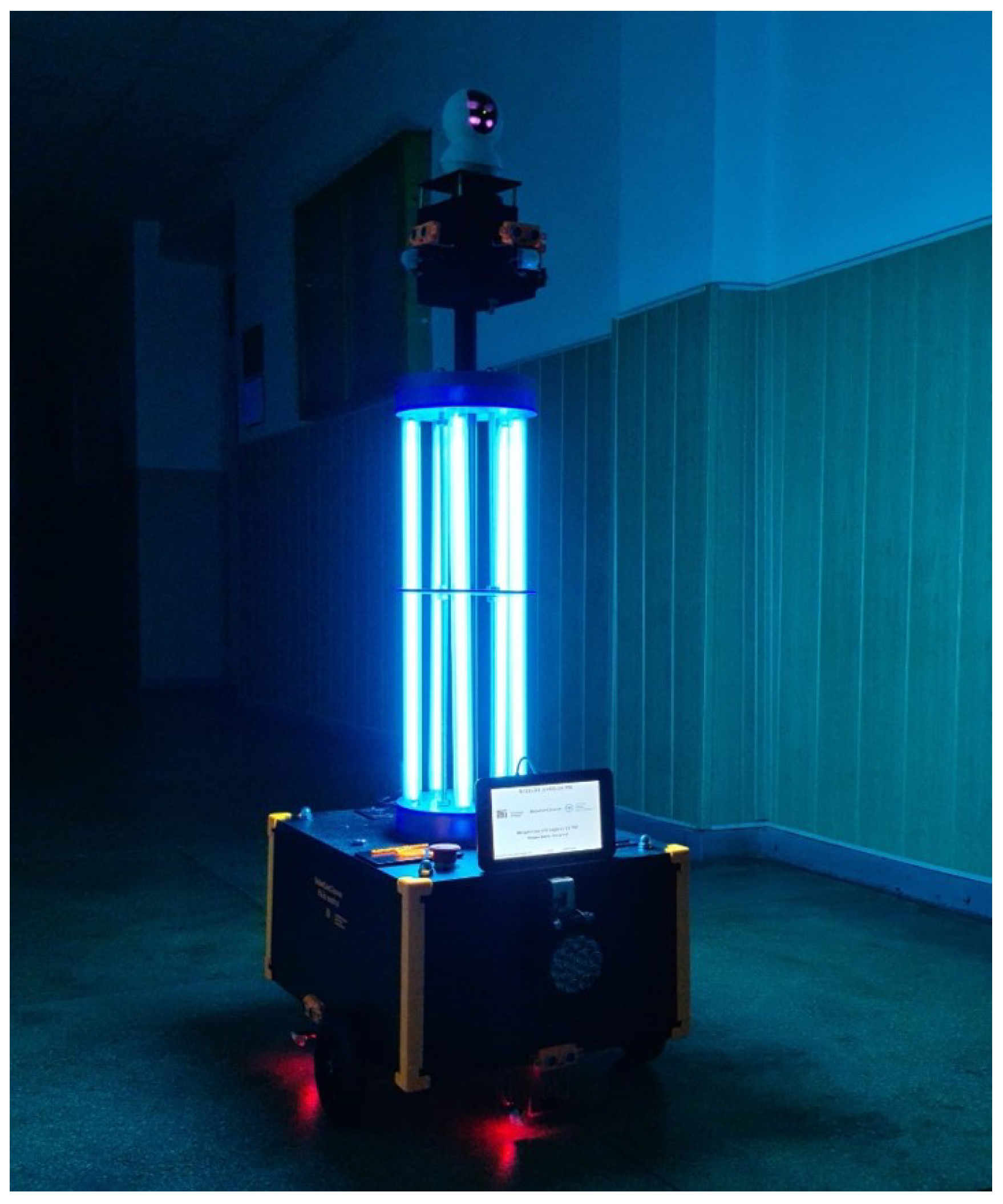




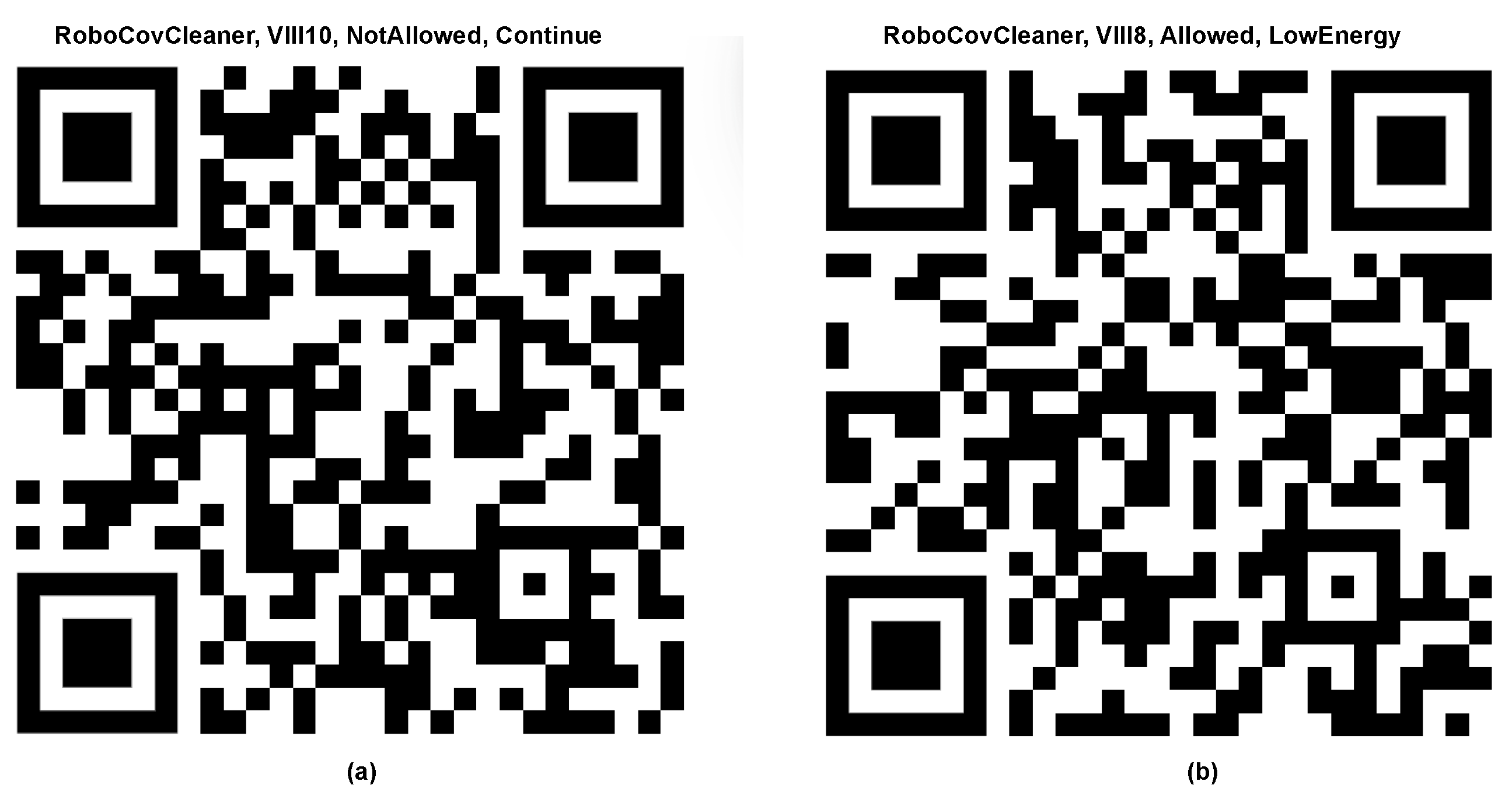

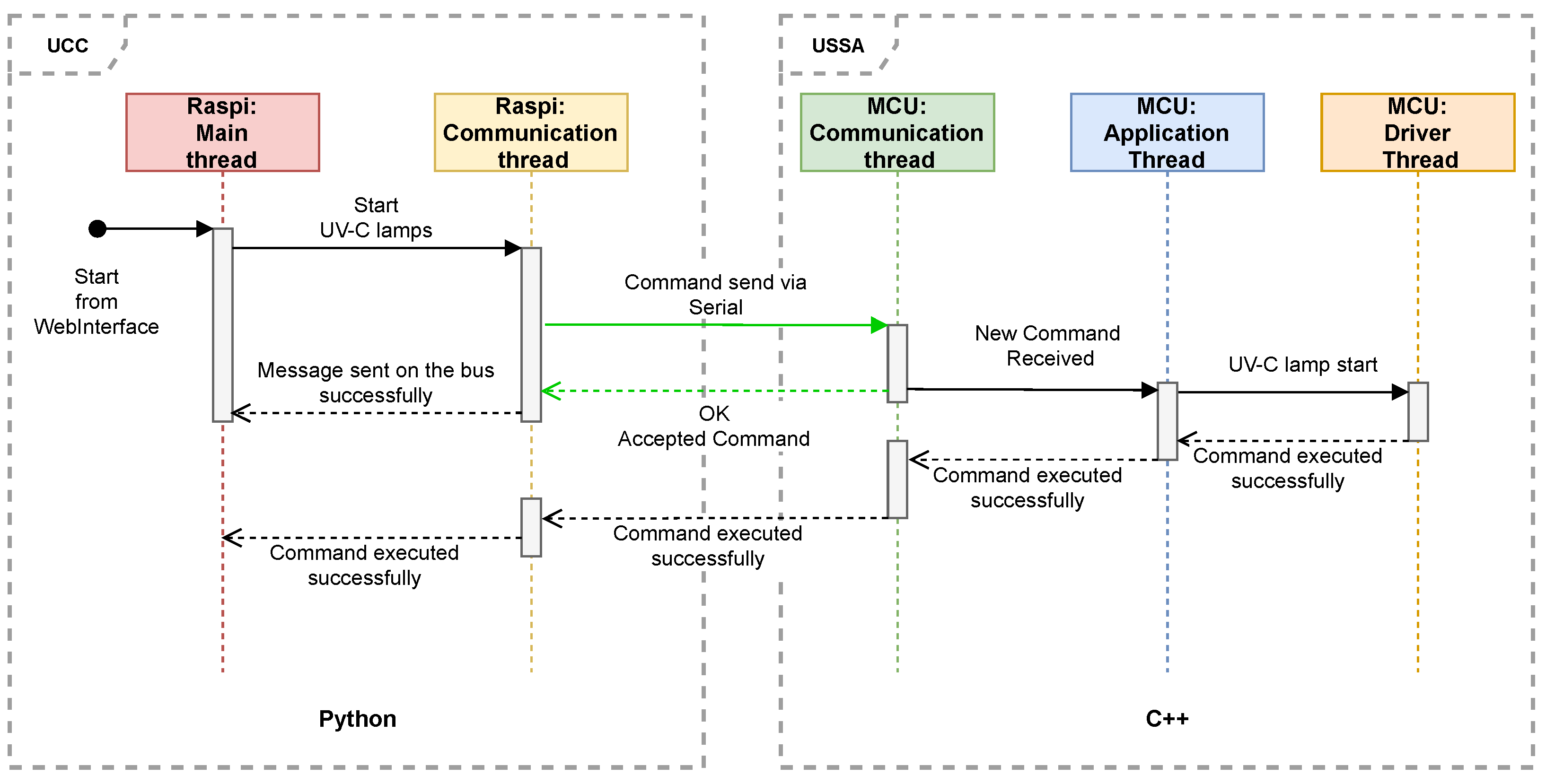
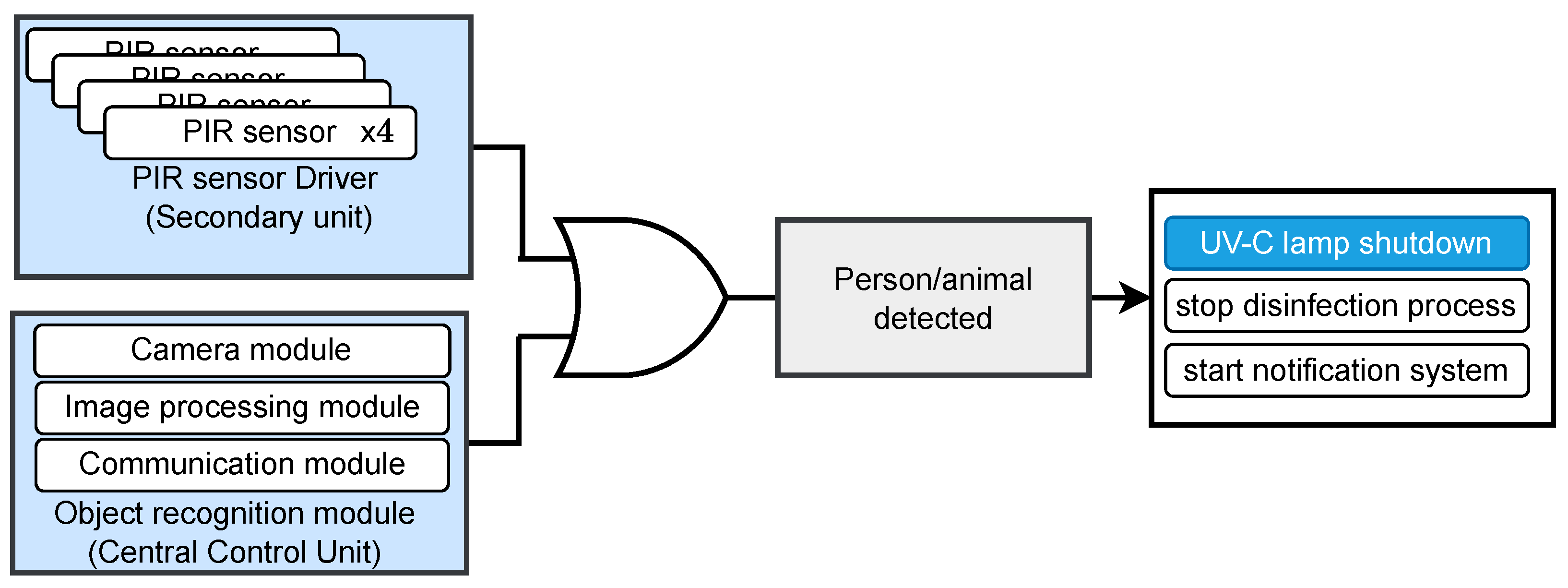
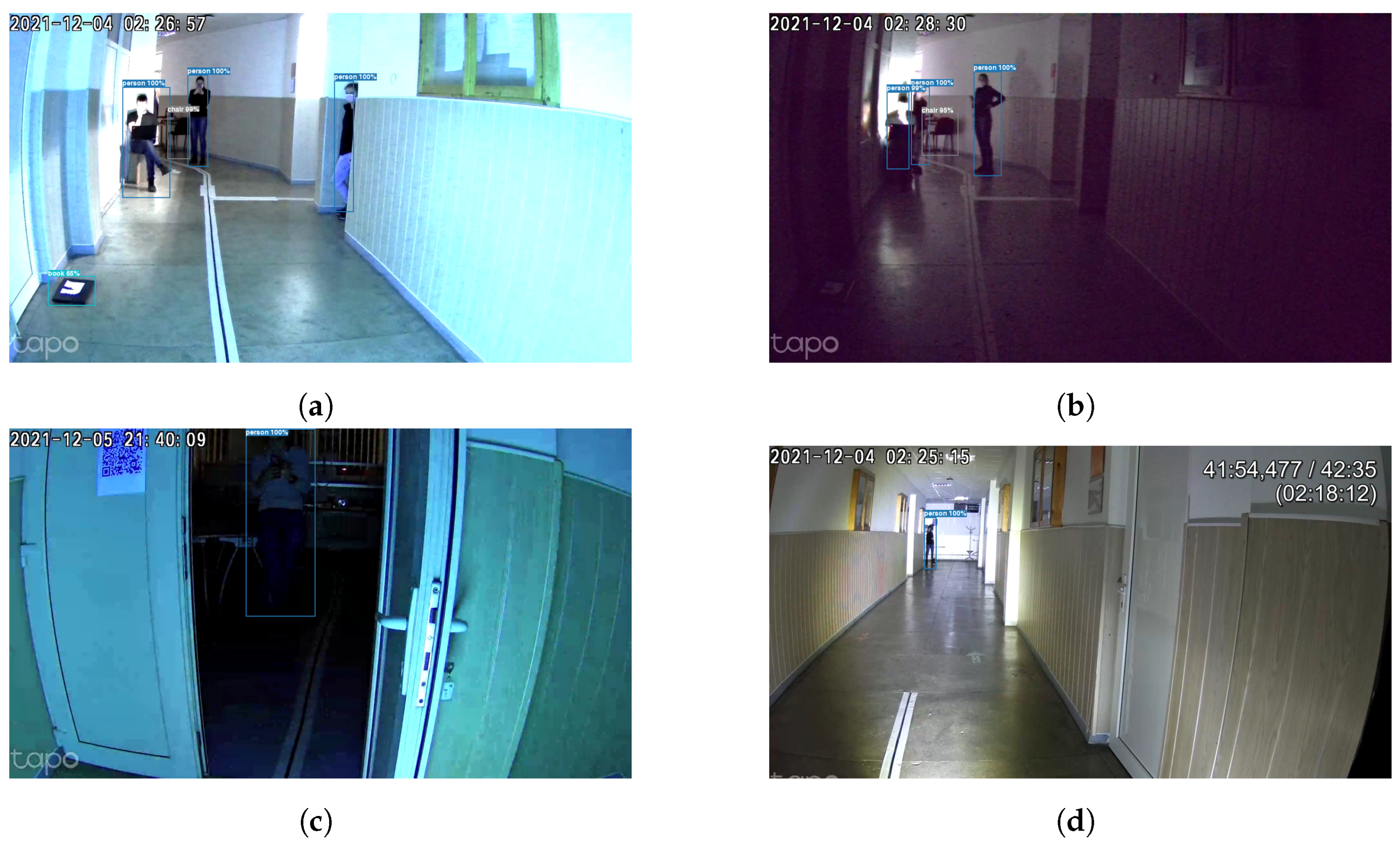

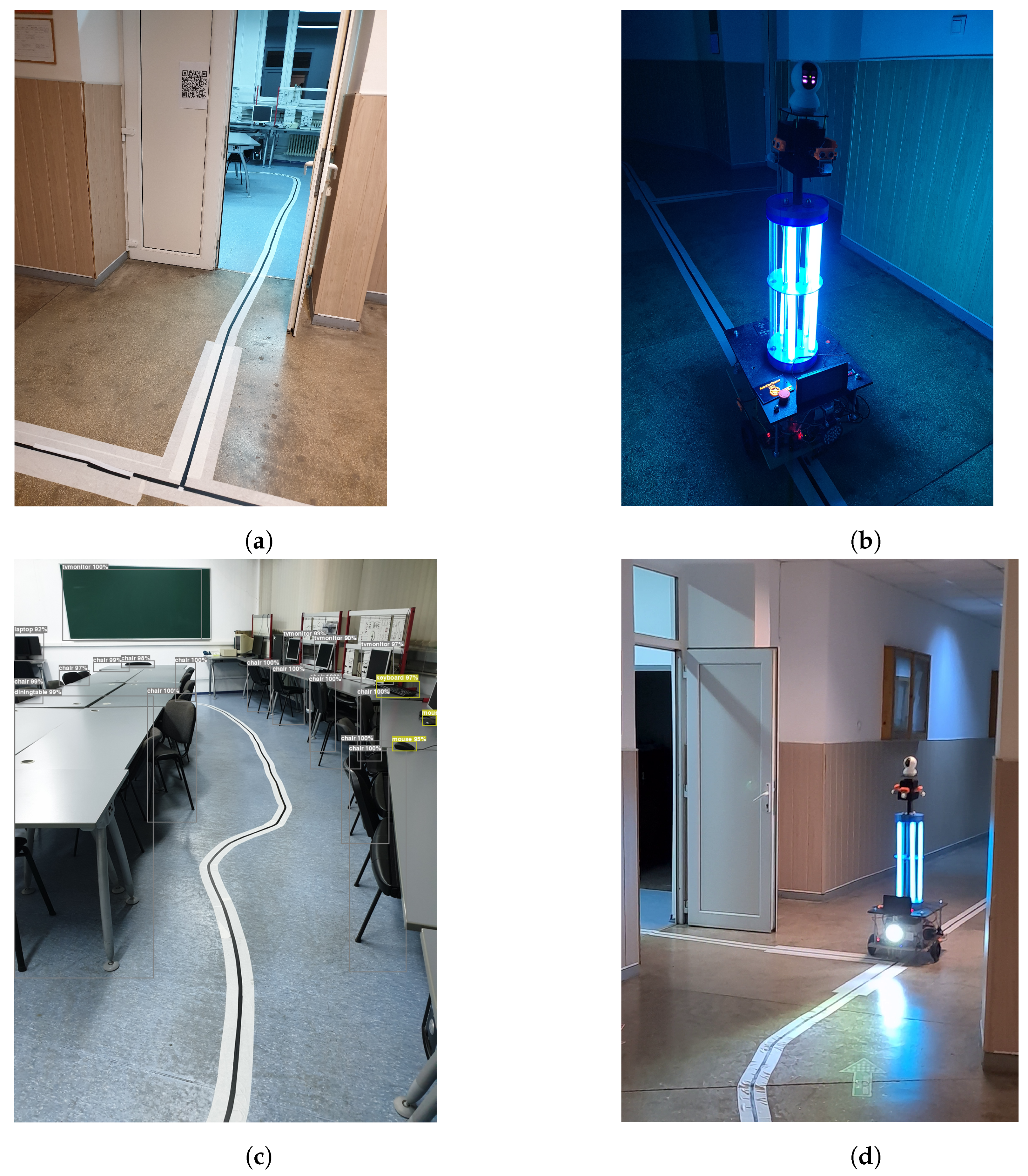
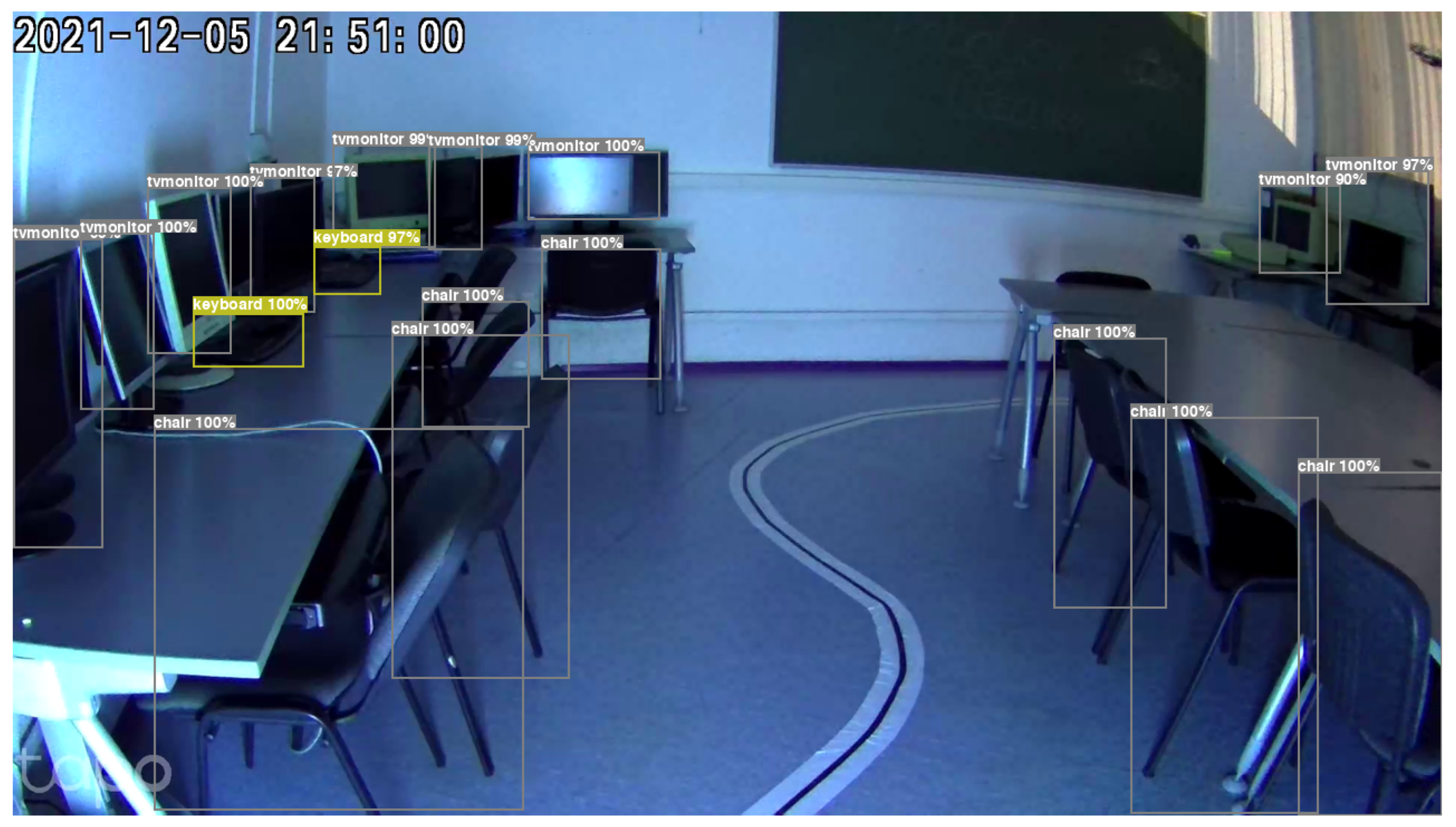
| Name | Price Range 1 | Disinfection System | Human Det. System |
|---|---|---|---|
| Xenex Lightstrike [6,7] | USD 100,000–USD 125,000 | Mobile base with 1×PXF-UV-C | 4×PIR Sensor |
| Tru-D Smart UV-C [8] | USD 100,000–USD 125,000 | Static base with 12×Double LPM UV-C | NO |
| UVD Robot [9] | USD 60,000–USD 100,000 | Mobile base with 8×LMP UV-C | 2×RGB-D Camera |
| Helios [10] | USD 90,000–USD 100,000 | Mobile base with 5×LMP UV-C, parabolic reflector | Motion sensors not on the robot |
| BKS-UVRobot-200 [11] | N/A 2 | Mobile base with 10×Quartz Lamp UV-C | NO |
| Honeywell Cabin System [12] | USD 10/single use | Static base with multiple size LMP UV-C | NO |
| Keenon M2 Robot [13,14] | USD 41,000–USD 50,000 | Mobile base with 4×LPM UV-C and spray(15L) | NO |
| SIFROBOT-6.59 [15] | USD 20,000–USD 25,000 | Mobile base with 6×LPM UV-C | NO |
| ZENZOE [16] | USD 90,000–USD 100,000 | Static/Mobile base with 4×LPM UV-C | NO |
| FARYUAN FYB-K3 [17] | N/A 2 | Mobile base with 4×Quartz Lamp, 2×LED UV-C and spray | NO |
| Name | Live F. 1 | OR 2 | Ctrl. 3 | Aut. 4 | Report | Upgr. 5 | Op. Time 6 |
|---|---|---|---|---|---|---|---|
| Xenex Lightstrike [7] | ✖ | ✖ | ✖ | ✖ | ✖ | SW | — |
| Tru-D Smart UVC [8] | ✖ | ✖ | ✔ | ✖ | ✔ | ✖ | — |
| UVD Robot [9] | ✖ | ✖ | ✔ | ✔ | ✔ | ✖ | 2 h |
| Helios [10] | ✖ | ✖ | ✔ | ✖ | ✖ | ✖ | — |
| BKS-UVRobot-200 [11] | ✖ | ✖ | ✔ | ✔ | ✔ | SW | 1.8 h |
| Honeywell Cabin S. [12] | ✖ | ✖ | ✔ | ✖ | ✖ | ✖ | — |
| Keenon M2 robot [13,14] | ✖ | ✖ | ✖ | ✔ | ✔ | ✖ | — |
| SIFROBOT-6.59 [15] | ✖ | ✖ | ✖ | ✔ | ✔ | ✖ | 3 h |
| ZENZOE [16] | ✖ | ✖ | ✖ | ✖ | ✖ | ✖ | 2.7 h |
| FARYUAN FYB-K3 [17] | ✖ | ✖ | ✖ | ✔ | ✖ | ✖ | 6 h |
| Name | Disinfection System | Human Detection System |
|---|---|---|
| Ultrabot [18] | Mobile base with 8×vertical static LMP UV-C (4 on each side) | Partially; depth sensing cameras (proximity detection only) |
| G-Robot [19] | Robot arm (5DOF) wtih 25×LED Far-UVC Lights | NO; Far-UVC light is safer, wavelengths range 207–222 nm |
| UVC-PURGE [20] | Mobile base with 6×vertical static LMP UV-C | NO |
| COVID-Bot [21] | Mobile base with 3×vertical static small LMP UV-C | NO |
| NLA-110 [22] | Static base with 4×vertical static LMP UV-C | NO |
| D. Robot 1 [23] | Mobile base with 1×static small LMP UV-C | NO; when disinfection starts the doors are locked |
| D. Robot 2 [24] | Mobile base with 7×vertical and horizontal static LMP UV-C and one UV-C spot placed on the arm | NO |
| Name | Live F. 1 | OR 2 | Ctrl 3 | Aut. 4 | Reports | Upgrade 5 |
|---|---|---|---|---|---|---|
| Ultrabot [18] | ✖ | ✖ | ✔ | ✔ | ✖ | ✖ |
| G-Robot [19] | ✖ | ✖ | ✔ | ✔ | ✖ | ✖ |
| UVC-PURGE [20] | ✔ | ✖ | ✔ | ✔ | ✖ | ✖ |
| COVID-Bot [21] | ✖ | ✖ | ✖ | ✔ | ✖ | ✖ |
| NLA-110 [22] | ✖ | ✖ | ✖ | ✖ | ✖ | ✖ |
| D. Robot 1 [23] | ✖ | ✖ | ✖ | ✔ | ✖ | ✖ |
| D. Robot 2 [24] | ✔ | ✖ | ✔ | ✖ | ✖ | ✖ |
| Component | Qty | Component | Qty |
|---|---|---|---|
| PIR Sensor HC-SR501 | 4 | Microchip ATmega2560 | 1 |
| Ultrasonic Sensor HC-SR04 | 8 | Raspberry Pi 4 Model B—8GB | 1 |
| IR Sensor TCRT5000 | 4 | 7″ Capacitive Touch LCD 800 × 480 | 1 |
| 12 V Battery Level Sensor | 1 | Slamtec RPLIDAR A1M8 2D 360 | 1 |
| QTR-8A Reflectance Sensor | 1 | DC to DC Converter | 1 |
| Pololu 24v18 Motor Driver | 1 | 12 V 10 Ah Battery | 1 |
| Pololu DC Motor (100:1) 12 V | 2 | Pololu 37Dmm Aluminum Standoff | 2 |
| Rubber Swivel Caster Wheel | 1 | 360-degree IR Camera | 1 |
| 4-Channel Relay Module 5V | 1 | MDF Plate | 1 |
| 12 V 42 W White 6000K Power LED | 1 | Nuts, Bolts of Various Sizes | — * |
| Philips 6 W T8 Tube Ballast | 5 | Various AWG Wires | — * |
| Philips 18 W Mercury UVC Lamps | 5 | Microchip ATMEL-ICE Debugger | 1 |
| 12V–220 V Inverter | 1 |
Disclaimer/Publisher’s Note: The statements, opinions and data contained in all publications are solely those of the individual author(s) and contributor(s) and not of MDPI and/or the editor(s). MDPI and/or the editor(s) disclaim responsibility for any injury to people or property resulting from any ideas, methods, instructions or products referred to in the content. |
© 2024 by the authors. Licensee MDPI, Basel, Switzerland. This article is an open access article distributed under the terms and conditions of the Creative Commons Attribution (CC BY) license (https://creativecommons.org/licenses/by/4.0/).
Share and Cite
Bratu, D.-V.; Zolya, M.-A.; Moraru, S.-A. RoboCoV Cleaner: An Indoor Autonomous UV-C Disinfection Robot with Advanced Dual-Safety Systems. Sensors 2024, 24, 974. https://doi.org/10.3390/s24030974
Bratu D-V, Zolya M-A, Moraru S-A. RoboCoV Cleaner: An Indoor Autonomous UV-C Disinfection Robot with Advanced Dual-Safety Systems. Sensors. 2024; 24(3):974. https://doi.org/10.3390/s24030974
Chicago/Turabian StyleBratu, Dragoș-Vasile, Maria-Alexandra Zolya, and Sorin-Aurel Moraru. 2024. "RoboCoV Cleaner: An Indoor Autonomous UV-C Disinfection Robot with Advanced Dual-Safety Systems" Sensors 24, no. 3: 974. https://doi.org/10.3390/s24030974
APA StyleBratu, D.-V., Zolya, M.-A., & Moraru, S.-A. (2024). RoboCoV Cleaner: An Indoor Autonomous UV-C Disinfection Robot with Advanced Dual-Safety Systems. Sensors, 24(3), 974. https://doi.org/10.3390/s24030974






